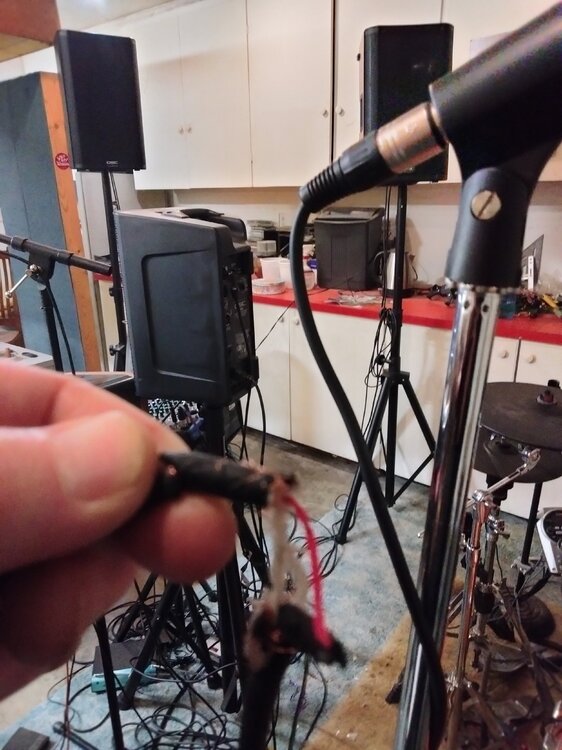-
Posts
3,369 -
Joined
-
Last visited
-
Days Won
22
Everything posted by bitflipper
-
I've always heard that experience is the best teacher. I disagree. What kind of teacher gives you the lesson after the test? My left hand has been programmed to do three things almost autonomously: play bass lines, CTL-S and CTL-Z. To address the original question...sometimes, you can recover a project (or at least most of it) but only after certain types of crashes. If the program takes a handled error on close, Cakewalk will offer to try (no promises) to recover the project. This has actually worked for me on at least one occasion I can recall. But if the project has never been saved and the program aborts due to an unhandled error, then there's nothing to recover. Personally, I do not use automatic saves because I want to choose the save points myself. Like right after nailing a difficult take. CTL-S. Sometimes I hit it twice because I don't remember doing it the first time, that's how automatic it is.
-

Why does ASIO buffer size affect Melda MHarmonizerMB quality?
bitflipper replied to Terry Kelley's question in Q&A
I use a Saffire Pro 40 too, and have had enormous MIDI-only projects with no issues. So it's not that. However, I have had the Focusrite go nuts on me with horrid distortion that sounds like buffer starvation - but only when watching YouTube videos or playing video games, not with Cakewalk. Not having a second interface to substitute, I tried reverting to the onboard Realtek audio for a day, using my monitors' built-in micro-speakers. Never heard a problem, except for it sounding tinny and quiet. I am using WASAPI Shared within Cakewalk, so the difference isn't the driver. Kinda looks like it may be the interface, but I don't want to spend $$$ for a new one only to find out that wasn't the problem, either. OTOH, I have been thinking about putting together a mobile rig to record my band live... -
Would be, except you haven't asked me for any vocals yet.
-

Deleting extra measures not needed at end of project
bitflipper replied to J. King's topic in Cakewalk by BandLab
Yeh, sounds like your default template is too long. Try creating a new template. Choose "Blank Project" from the New Project dialog, add in everything you want to have in there by default, and then save it to the templates folder as Default. Custom templates are very handy. For example, if you always add a reverb bus or a drum bus, include them in the template. -
Yeh, I'm sure you guys are right about it being a Native Instruments licensing thing. Although NI is very secretive about their licensing, I do know that it's based on how many copies are sold. Or in some cases, vendors have to estimate in advance how many copies they expect to sell. Some developers have been unhappy with that arrangement, so they may not do that anymore. Like I said, NI is secretive about it and even make licensees submit NDAs. I'm guessing Project SAM is only going to sell as many licenses as they've already paid NI for. Although it seems to me it'd make more sense to just keep selling product and re-brand it as "Full Kontakt Required". There was a brief time when some vendors offered both Player and Full versions, with the former being about 20 bucks more. Those of us who own full Kontakt would appreciate not having to pay the license fee.
-
Yes, it's usually a plugin that's at fault. But with a large project it can be quite time-consuming to narrow down just which one it is. If Cakewalk aborts with no error message or dump file, you can tell it to be more verbose in its error reporting. By default, many routine error conditions are not reported. To make it less obtuse, there is a setting in CAKEWALK.INI named ExceptionHandlingSeverity. This tells the software what kinds of errors to complain about and which ones to let slide. Set this value to 5 or 7 for troubleshooting. Warning: it can get wordy when told to report everything, so you might want to revert it back to its default value of 1 once you've figured out your problem.
-
Kenny, when I first saw that video I thought someone had sent me a pic of my own dog. He looks almost exactly like that, jet black with a white stripe and little white tufts on his toes. Yikes, I guess they're all 3D-printed now from a standard set of plans.
-
I'd called the nearest tuner to me and got his voicemail, left a message but he never called me back. On to the next one on the list.
-
What do they do, delete one copy from the server after every sale?
-
Spent the day bonding with the puppy. So cute. Only cost me 50 bucks...ordered a pack of 2 just in case I have to puppy-sit again.
-

Deleting extra measures not needed at end of project
bitflipper replied to J. King's topic in Cakewalk by BandLab
I don't bother with hunting down stray events anymore. Instead, I place a marker where I want the export to end (creatively named "End", with a corresponding marker called "Start"). Then, in the export dialog, I select everything from Start to End. Select "Time Selection" under the Range dropdown. Click the ellipse button to select a marker as the time range end. Cakewalk will remember these settings, but they don't automatically move if you move the marker. -
All of these songs are available on CD or MP3. I bought one titled "Songs Around the World 10 Year Anniversary (Remastered) Edition". It's been my falling-asleep music for the past few nights. Good stuff. My favorite cuts are the not-so-familiar tunes, e.g. Biko. However, last night I awoke with a start after realizing they'd altered the harmonies on the chorus of "All You Need is Love". Specifically, they took out George Harrison's descending part. It's a small thing, but I don't think I can fall asleep to that one anymore. It's like having one dark pixel on your display: once noticed you cannot un-see it.
-
First day puppy-sitting on my own. I had this idea that I'd leave the door open to my garage/office/studio and he could freely wander in and out. Preferably mostly out. Too many things to chew on in here. So there's the door wide open but where does he choose to take a dump? On my carpet, of course. At least he's been running around cleaning up all the cobwebs from the far corners of the room. Yeh, I could bring in the shop vac, but my theory is that cobwebs, if allowed to accumulate, provide additional acoustical absorption.
-
Remember that cute kid back on page 3? Probably figured she'd be a monster grown up. Yup.
-

Just how bad has today's Citizen Regen songs become?
bitflipper replied to Citizen Regen's topic in The Coffee House
Fearlessly overcoming such obstacles is inspiring. Makes me think that I, too, could prevail despite having less than a thousand plugins. -
Credit to bapu for the mix. There's a lot going on in there. In truth, when he first presented this one to me I declined to contribute, saying it would be better to approach it as a power trio seeing as how it was already so dense. Kudos to Ed for refusing to take "no" for an answer and figuring out how to create a space for me so I could channel my inner Jon Lord. Actually, because Jon is still alive I should have said "channeling my inner Keith Emerson". But in truth I'm not that good.
-

Live Musik machen ohne Aufnahme (Cakewalk)
bitflipper replied to Gyula's topic in Cakewalk by BandLab
Yes, it's normal that the bus does not show a waveform, because unlike a track it doesn't contain any actual data. Don't know anything about that interface, sorry. (Entschuldigung, es ist 50 Jahre her, dass ich täglich Deutsch gesprochen habe. Und das war bayerisches Deutsch. :) -
That method still works, and the Sonitus compressor is still a good choice for doing it. Other compressors can add some flexibility, e.g. having a sidechain filter is handy for fine-tuning. A FET-style compressor can give you very fast attack times if that's what you need. Multi-band compressors let you duck specific frequencies, which can make the action more transparent because you're only ducking frequencies that are most likely to mask another track (e.g. ducking a distorted rhythm guitar with a vocal as the sidechain input).
-

K (mute) command makes Clip Disappear
bitflipper replied to Lenny Greene's topic in Cakewalk by BandLab
Do you mean the Melodyne data disappears, or the region becomes hidden? -
I'm having fun with it. Manglers aren't normally part of my go-to kit, as my instinct is to go for naturalistic sounds. But there's a place in the blandest porridge for a little cinnamon. There is a readme that tells you what the controls actually do. So yes, the obtuse names are intentional. "Regret", for example, alters the sample rate down to as low as 2KHz. "Sorrow" controls playback speed of the gated signal. "Weep" pitch-shifts the signal to one of six scales. "Dwell" gives a frozen reverb tail.
-
I am reminded of the old joke...man goes to a fortune teller who informs him he'll experience a devastating tragedy in 12 years. Which he finds depressing. So depressing he gets a puppy to cheer himself up.
-
Nah, cats are self-centered jerks. Well, mine's pretty mellow, but still. Last night we added a puppy to the household. I got up early this morning to make sure he got outside to pee. My reward: first one to step in a fresh pile of poo. No, it wasn't outside.
-
It's basically a tremolo effect, but it can do weird and fun stuff to the signal, e.g. pitch-shifting, bitcrushing, down-sampling. Use the "Odd" and "Even" knobs to select the tempo unit for syncing. "Door" controls the depth; turn it fully clockwise for a stutter effect.
-
Oops. Thanks, Larry. Here's the cryptic UI, which the dev describes as "intentionally vague" to encourage serendipitous experimentation. Gotta love a plugin with a "Regret" knob.
-
Just downloaded this to test. It's free. 32- and 64-bit, VST2 and VST3.








